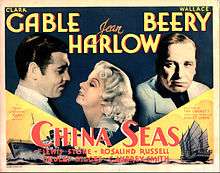China Seas (film)
| China Seas | |
|---|---|
 Lobby card | |
| Directed by | Tay Garnett |
| Produced by |
Irving Thalberg Albert Lewin |
| Written by |
James Kevin McGuinness Jules Furthman |
| Based on |
China Seas 1931 novel by Crosbie Garstin |
| Starring |
Clark Gable Jean Harlow Wallace Beery Lewis Stone Rosalind Russell Robert Benchley |
| Music by | Herbert Stothart |
| Cinematography |
Ray June Clyde De Vinna (2nd unit) |
| Edited by | William LeVanway |
| Distributed by | Metro-Goldwyn-Mayer |
Release dates |
|
Running time | 87 minutes |
| Country | United States |
| Language | English |
| Budget | $1,138,000[1][2] |
| Box office | $2,867,000[1][2] |
China Seas is a 1935 adventure film starring Clark Gable as a brave sea captain, Jean Harlow as his brassy paramour, and Wallace Beery as an extremely suspicious-looking character. The oceangoing epic also features Lewis Stone, Rosalind Russell, Akim Tamiroff, and Hattie McDaniel, while humorist Robert Benchley memorably portrays a character reeling drunk from one end of the film to the other.
The lavish MGM epic was written by James Kevin McGuinness and Jules Furthman from the book by Crosbie Garstin, and directed by Tay Garnett. This is one of only four sound films with Beery in which he didn't receive top billing.
Plot
Alan Gaskell (Clark Gable) is the captain of a tramp steamer chugging between Singapore and Hong Kong. Dolly Portland (Jean Harlow) is Alan's former girlfriend who books passage on the steamer at the same time that another of Alan's former loves, aristocratic Sybil Barclay (Rosalind Russell), shows up. Jamesy McArdle (Wallace Beery) is a passenger, who is actually in league with a gang of pirates who plan to steal the gold shipment being carried on the steamer.[3]
Cast
- Clark Gable as Captain Alan Gaskell
- Jean Harlow as Dolly 'China Doll' Portland
- Wallace Beery as Jamesy McArdle
- Lewis Stone as Tom Davids
- Rosalind Russell as Sybil Barclay
- Dudley Digges as Dawson
- C. Aubrey Smith as Sir Guy Wilmerding
- Robert Benchley as Charlie McCaleb
- Akim Tamiroff as Paul Romanoff
- William Henry as Rockwell
- Liev De Maigret as Mrs. Vollberg (credited as Live de Maigret)
- Lilian Bond as Mrs. Timmons (credited as Lillian Bond)
- Edward Brophy as Timmons
- Soo Yong as Yu-Lan
- Carol Ann Beery as Carol Ann
- Ivan Lebedeff as Ngah
- Hattie McDaniel as Isabel McCarthy, Dolly's Maid (uncredited)
- Donald Meek as Passenger playing chess (uncredited)
Production
Irving Thalberg had worked on the film since 1930 when he assigned three different writers to come up with three different treatments. By 1931 Thalberg had decided on the one storyline and spent the next four years working on a script with two dozen writers, half a dozen directors and three supervisors.[2]
Gable had several temper tantrums on the set, which were tolerated by MGM studio chief Louis B. Mayer because the star had recently won an Academy Award for Best Actor in It Happened One Night (1934) on a loan-out to Columbia Pictures, and he did not want to risk losing him. Mayer even tolerated that Gable risked his life by refusing a stunt double in a sequence in which he assisted numerous Chinese extras in roping in a runaway steamroller that crashed up and down the decks of the cantilevered studio ship.[4]
Reception
The film was a big hit earning $1,710,000 in the US and Canada and $1,157,000 elsewhere resulting in profits of $653,000.[1][2]
References
- 1 2 3 The Eddie Mannix Ledger, Los Angeles: Margaret Herrick Library, Center for Motion Picture Study.
- 1 2 3 4 Scott Eyman, Lion of Hollywood: The Life and Legend of Louis B. Mayer, Robson, 2005 p 155-156
- ↑ http://www.allmovie.com/movie/china-seas-v9335
- ↑ Higham, Charles (Dec 1994) [1993]. Merchant of Dreams: Louis B. Mayer, M.G.M., and the Secret Hollywood (paperback ed.). Dell Publishing. p. 265. ISBN 0-440-22066-1.
External links
| Wikimedia Commons has media related to China Seas (1935 film). |
- China Seas at the Internet Movie Database
- China Seas at AllMovie
- China Seas at the TCM Movie Database
- China Seas at the American Film Institute Catalog
- China Seas at malayablackandwhite